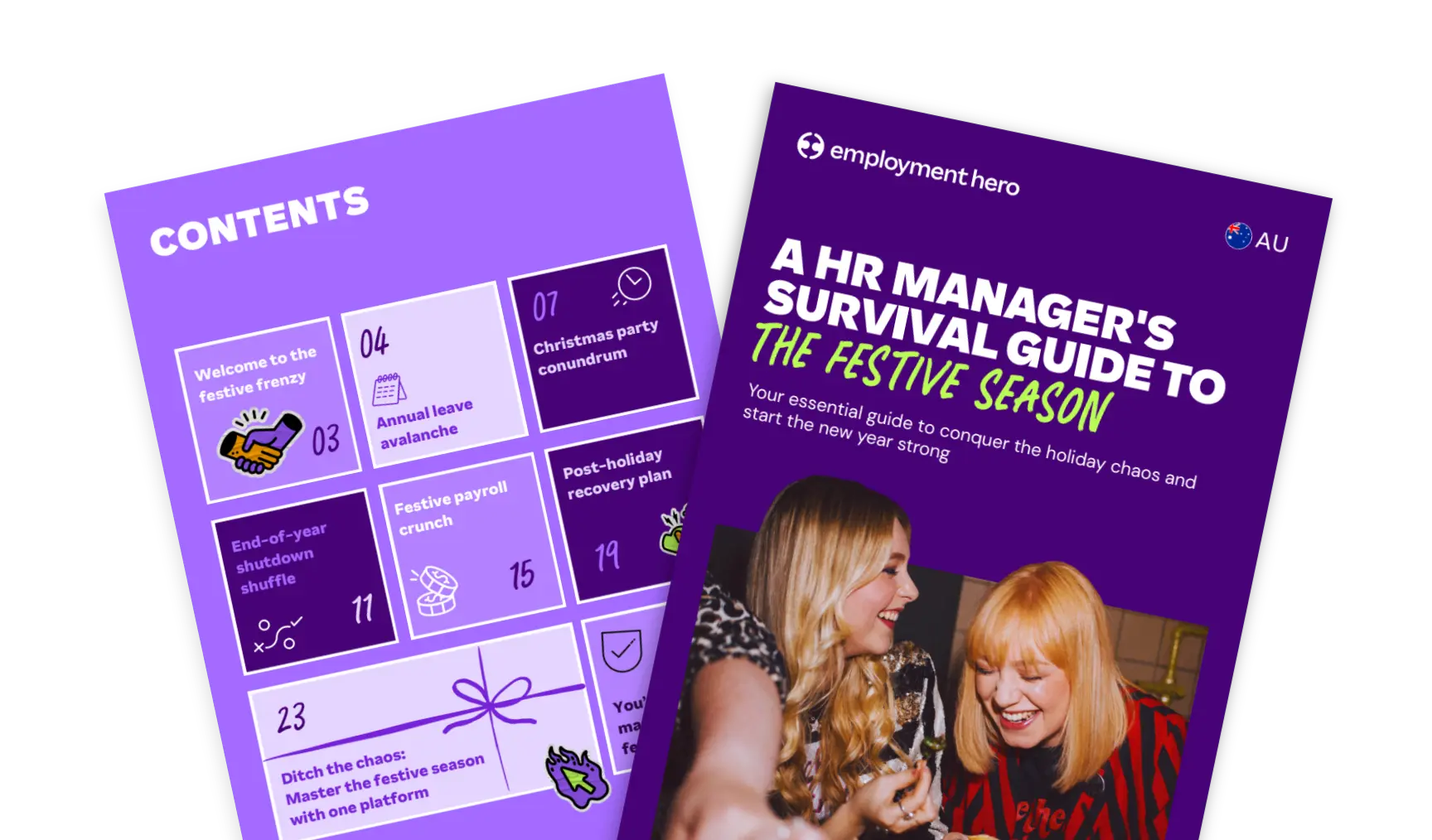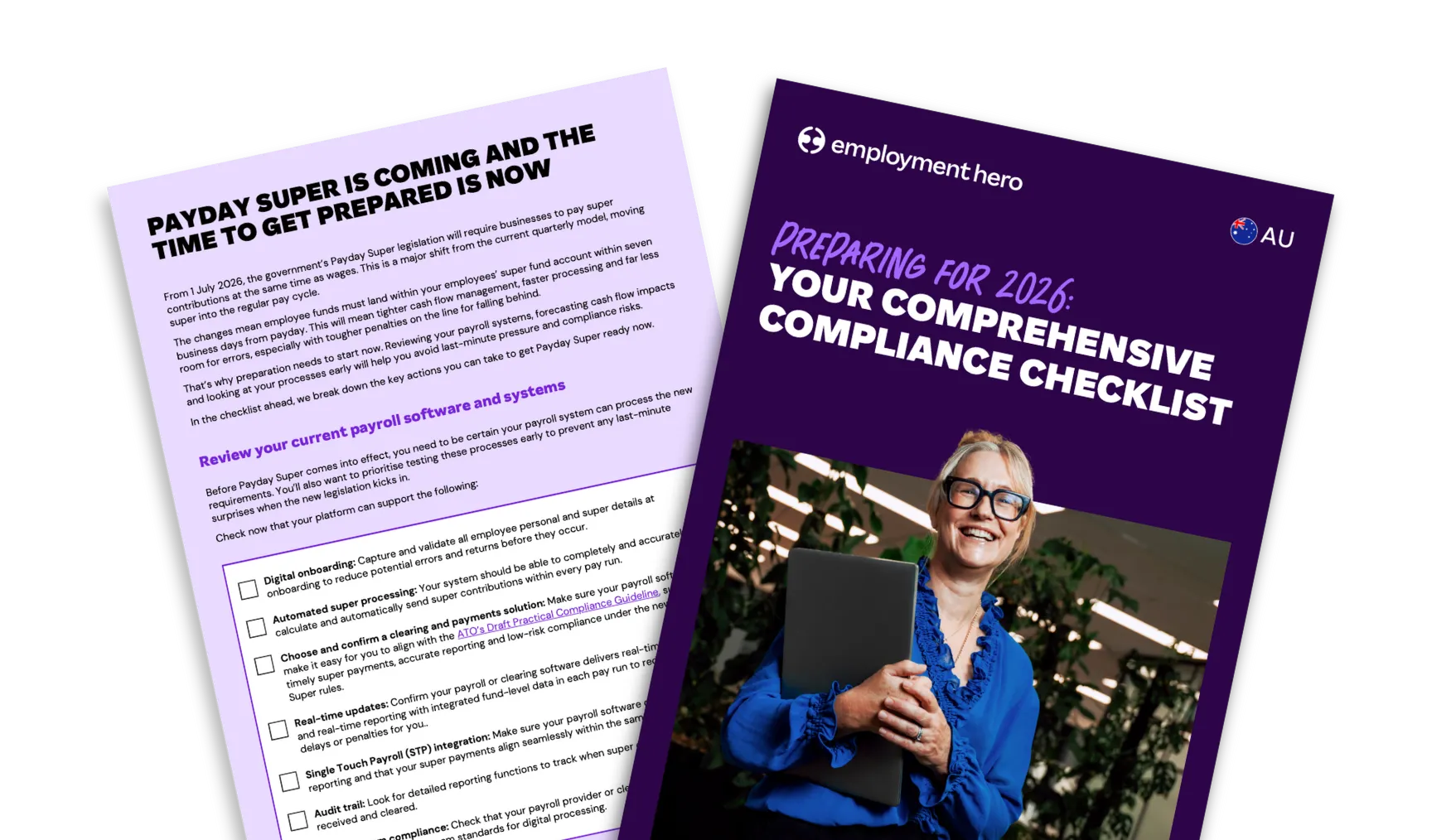HR compliance checklist for small business in Australia
Published
HR compliance checklist for small business in Australia
Published

Managing a business in Australia means navigating a complex web of rules and regulations. For small and growing businesses, human resources compliance can feel like a moving target.
This ultimate HR compliance checklist will guide you through the essentials, plus all relevant laws, helping you build a compliant and resilient workplace. In here, you’ll find checklists for each stage of the employee lifecycle, including:
- Job listings, screening and shortlisting
- The interview process
- Reference and background checks
- Contracts and employment agreements
- Payroll setup
- Onboarding and induction
- Your ongoing obligations
Download the small business HR compliance checklist now.
What is HR compliance?
HR compliance is the process of making sure your business adheres to all applicable laws and regulations. It covers every stage of the employee lifecycle, from hiring and onboarding to payroll, employee management and termination.
In Australia, this means aligning your practices with a framework of federal, state and territory legislation designed to protect employees and ensure fair working conditions.
Why HR compliance matters for Australian businesses
For a growing business, the cost of non-compliance can be crippling. It goes far beyond a simple fine. Failure to meet your legal duties can lead to expensive employee disputes, back-pay claims and costly fines from regulatory bodies.
Beyond the financial impact, non-compliance can damage your reputation, making it harder to attract and retain top talent. Proactive compliance efforts show your commitment to being a fair and ethical employer, building trust with your team and strengthening your brand. this change to super? Check out our Payday Super hub for all of the latest updates.

Using your HR compliance checklist
This guide is structured to act as your foundational compliance checklist. Work through each section to review your current processes, identify potential gaps and take corrective action. Treat it as a dynamic tool, revisiting it regularly to make sure your policies and procedures remain up to date with legislative changes.
Key Australian employment laws to know
Understanding the legislative landscape is the first step. While many laws apply, several key pieces of federal legislation form the backbone of Australia’s workplace relations system.
Fair Work Act
The Fair Work Act is the primary legislation governing employment in Australia. It sets the minimum standards for most private-sector employees. Key compliance requirements under this act include adhering to the National Employment Standards (NES), paying correct wages under modern awards or enterprise agreements and preventing unlawful workplace practices like discrimination and unfair dismissal.
Modern awards and enterprise agreements
Modern awards are industry or occupation-specific documents that outline minimum wage rates, working hours, overtime, penalty rates and other entitlements. There are over 120 modern awards, making it crucial to identify and apply the correct one to your employees. Misclassifying an employee under the wrong award is a common and costly compliance error.
Enterprise agreements are negotiated at the business level and, once approved by the Fair Work Commission, replace the relevant modern award.
National Employment Standards (NES)
The NES are 12 minimum entitlements that apply to all employees covered by the national workplace relations system, regardless of their award or agreement. You cannot provide conditions that are less than these standards.
The 12 entitlements are:
- Maximum weekly hours of work: 38 hours for full-time, plus reasonable additional hours.
- Requests for flexible working arrangements: eligible employees may request changes to hours/patterns/locations.
- Parental leave and related entitlements: up to 12 months unpaid and right to ask for additional 12 months.
- Annual leave: 4 weeks paid per year for full-time and part-time employees.
- Personal/carer’s leave, compassionate leave and paid family and domestic violence leave: includes 10 days paid personal/carer’s leave (for full-time and part-time employees); 2 days unpaid carer’s leave,2 days compassionate leave (only paid for full-time and part-time employees) and 10 days paid family and domestic violence leave for all employees including casuals.
- Community service leave: unpaid leave for voluntary emergency management activities and paid leave for jury duty (up to 10 days) for full-time and part-time employees.
- Long service leave: an entitlement for employees with long service, paid for all employees including casuals (state/territory laws apply).
- Public holidays: a day off on a public holiday (unless requested to work and the employee accepts).
- Notice of termination and redundancy pay: minimum notice based on length of service and redundancy pay up to set amounts (not applicable to casuals).
- Superannuation contributions: employers must make contributions to eligible employees under the super guarantee laws.
- Provision of the Fair Work Information Statement, the Casual Employment Information Statement and the Fixed Term Contracts Information Statement.
- Casual conversion: employee choice to convert from casual employment to permanent employment.

Pre-employment compliance requirements
Compliance begins before an employee’s first day. Your hiring process must be fair, transparent and compliant.
Employment contract compliance
A well-drafted employment contract is your first line of defence. It should clearly outline the terms and conditions of employment, including the employee’s duties, remuneration, hours of work and leave entitlements.
All employment contracts must meet or exceed the minimum entitlements set out in the NES and any applicable award or enterprise agreement. You want to be specific in your employment contracts, as ambiguity in agreements can lead to disputes down the line.
Right to work in Australia verification
You should verify that every employee has the right to work in Australia. This could mean using the Visa Entitlement Verification Online (VEVO) system for non-citizens. Hiring someone without the legal right to work can result in significant penalties.
Fair Work Information Statement requirements
You must give every new employee a copy of the Fair Work Information Statement (FWIS) before, or as soon as possible after, they start their new job.
For casual employees, you must also provide the Casual Employment Information Statement (CEIS).
For employees on a fixed-terms contract, they must be provided with the Fixed Term Contract Information Statement.
These documents provide new employees with information about their minimum rights and conditions of employment.

Payroll and wage compliance requirements
Paying your employees correctly and on time is a compliance obligation. Here’s what you need to be across.
Single Touch Payroll (STP) compliance
STP is a mandatory Australian Taxation Office (ATO) initiative that requires you to report employees’ payroll information, such as salaries, wages, tax withheld and superannuation, each time you run your payroll.
This ensures you’re reporting accurate information to the ATO in real time. Using HR and payroll software, like Employment Hero, simplifies this process.
Minimum wage and award rate compliance
You must pay your employees at least the national minimum wage or the rate specified in their modern award or enterprise agreement. The Fair Work Commission reviews the national minimum wage laws and modern award minimum wages annually. Staying up to date with these changes is essential to avoid underpayment. Be vigilant about pay classifications, as assigning an employee to the wrong level within an award can lead to systemic underpayment.
Overtime and penalty rates compliance
Modern awards and enterprise agreements often specify higher rates of pay (penalty rates) for working on weekends, public holidays or late at night.
They also include rules for overtime pay when an employee works beyond their ordinary hours. You must calculate and pay these rates correctly for every relevant pay period. Failure to do so is a common breach of the Fair Work Act.
Leave entitlements compliance checklist
Properly managing and tracking leave is a core compliance task.
- Annual leave: Full-time and part-time employees accrue four weeks of paid annual leave per year.
- Personal/carer’s leave: Accrues at a rate of 10 days per year for full-time employees and pro-rata for part-time employees.
- Long service leave: Rules vary between states and territories, but both permanent and casual employees generally become entitled to a period of paid leave after a long period of continuous service. Read our full guide on long service leave.
- Parental leave: The NES provides for up to 12 months of unpaid parental leave (with the option to request an additional 12).
Work health and safety (WHS) compliance
Creating a safe working environment is a non-negotiable legal duty. WHS laws exist at both federal and state/territory levels.
Workplace safety obligations for employers
As an employer, you have a primary duty of care to ensure the health and safety of your workers so far as is reasonably practicable. This involves eliminating or minimising risks to workplace health and safety. This duty extends to employees, independent contractors, volunteers and anyone else in the workplace.
Risk assessment and safety documentation
Proactive workplace safety management involves identifying hazards, assessing the associated risks and implementing control measures. You must document this process and regularly review its effectiveness. This includes developing safe work procedures and providing adequate safety training to your team.
Incident reporting requirements
You are required to notify your state or territory WHS regulator of any “notifiable incidents,” which include the death of a person, a serious injury or illness, or a dangerous incident. Timely reporting is crucial for compliance and for preventing future incidents.
Privacy and data protection compliance
When you hire someone, you collect a significant amount of personal and sensitive information. The Privacy Act 1988 governs how you must handle this data. You have an obligation to protect employee information from misuse, interference, loss and unauthorised access. This includes securing both digital and physical records.
Employee record-keeping requirements
The Fair Work Regulations 2009 mandate that you must keep certain employee records for seven years. Proper record-keeping is a legal requirement and your evidence in case of a dispute. Records must be accurate, readily accessible and kept confidential.
How long to keep HR records in Australia
- Payroll records: 7 years (includes pay rates, hours worked, leave and superannuation).
- Employment contracts and individual flexibility arrangements: 7 years after employment ends.
- Termination records: 7 years.
Anti-discrimination and equal opportunity compliance
Federal, state and territory anti-discrimination laws make it illegal to treat someone unfairly because of a protected attribute, such as age, race, sex, disability or sexual orientation. This applies to all stages of employment, from recruitment to termination. Fostering a diverse and inclusive workplace is key to meeting these obligations.
Workplace bullying and harassment prevention
You have a duty to provide a workplace free from bullying and harassment. This requires implementing clear company policies, providing regular training to all staff and managers and establishing a confidential and fair process for handling complaints. Taking proactive steps is essential to manage this significant workplace health and safety risk.
HR compliance software and tools
Manual compliance management is prone to error and incredibly time-consuming. Modern HR software automates many of these critical tasks. It can help you onboard new employees correctly, manage employment contracts, track leave entitlements and maintain digital employee records, all in one secure platform. HR software makes staying on top of your compliance obligations easier and more reliable.

How to stay updated on HR law changes
Employment laws are constantly evolving. To keep up to date with your compliance obligations, you must stay informed. Here’s our top tip:
- Subscribe to updates from the Fair Work Ombudsman and Safe Work Australia.
- Join industry associations that provide legislative updates.
- Consult with HR experts for extra support via our HR Advisory Service. They can provide you with employment advice to navigate complex HR issues and ensure your practices are always up to date.
HR compliance training for managers
Your managers are on the front line of HR compliance. They’re responsible for implementing the company’s policies, managing performance and approving leave. Providing them with training on topics like Fair Work, WHS and anti-discrimination laws empowers them to make compliant decisions and reduce the business’s legal risk exposure.
Download the HR compliance checklist
Feeling overwhelmed? Don’t be. To help you get started and stay on track, we’ve created detailed resources.
Begin with our HR Audit Checklist to assess your current processes and then check out our HR Compliance: Your Essential Guide for a deeper dive.
If you’re new to the role, our guide on navigating Your First 90 Days as a New HR Manager will set you up for success. By taking a structured approach, you can build a strong foundation of human resources compliance and focus on growing your business.
Download the small business HR compliance checklist now.
Disclaimer: The information in this checklist is current as at November 2025, and has been prepared by Employment Hero Pty Ltd (ABN 11 160 047 709) and its related bodies corporate (Employment Hero). The views expressed in this checklist are general information only, are provided in good faith to assist employers and their employees, and should not be relied on as professional advice. The Information is based on data supplied by third parties. While such data is believed to be accurate, it has not been independently verified and no warranties are given that it is complete, accurate, up to date or fit for the purpose for which it is required. Employment Hero does not accept responsibility for any inaccuracy in such data and is not liable for any loss or damages arising either directly or indirectly as a result of reliance on, use of or inability to use any information provided in this checklist. You should undertake your own research and to seek professional advice before making any decisions or relying on the information in this checklist.
Register for the checklist
Related Resources
-
 Read more: HR Managers: Don’t just survive the festive season, master it
Read more: HR Managers: Don’t just survive the festive season, master itHR Managers: Don’t just survive the festive season, master it
Make year-end easier: manage leave, payroll, parties and shutdowns with confidence. Get practical tips for Australian SMEs. Download the free…
-
 Read more: Preparing for 2026: Your Compliance Checklist
Read more: Preparing for 2026: Your Compliance ChecklistPreparing for 2026: Your Compliance Checklist
Get your business ready for the 1 July 2026 changes. See practical steps for Payday Super, cash flow planning and…
-
 Read more: Monthly business budget template for employers
Read more: Monthly business budget template for employersMonthly business budget template for employers
Plan your monthly income and expenses with our free monthly business budget template. Download today to track cash flow and…























